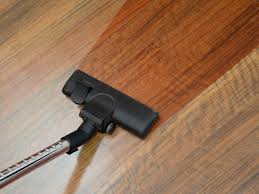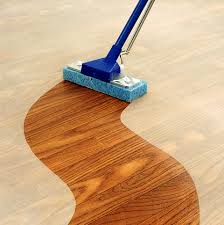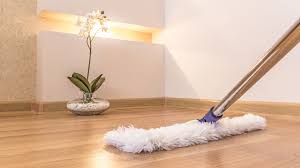The Best Way to Clean Wood Floors
Hardwood flooring manufacturers recommend using the least intrusive cleaning techniques possible for your wood floors. If you sweep and vacuum often, you shouldn’t have to do much else, but when a cleaner is needed, it should be a pH-neutral one. Acidic or caustic cleaners can etch the finish and make it look hazy, abrasive cleaners can scratch, and oil soaps can leave residues that make the floor look worse than it did before cleaning.
You’re Cleaning the Finish, Not the Wood
Most contemporary hardwood floors have a coating of polyurethane varnish, and when you wash the floor, you’re really washing the finish. Although it’s durable, polyurethane scratches, and certain chemicals react with it to make it appear cloudy. Ammonia has a high pH and can basically corrode polyurethane, and full-strength vinegar has a low pH that can etch it. Many experts recommend cleaning hardwood floors with a solution of vinegar and water, but you should never use vinegar at full strength. Abrasive cleaners, such as scouring powder, dull the finish in a different way; they leave microscopic scratches. Steel wool and abrasive brushes can have the same effect.
Avoid Oily Cleaning Products
Many consumers have complained about certain wood cleaning products available on the market. These products do a good job on your wood furniture but aren’t good for your floors, because they contain vegetable oils or waxes that remain on the surface after the cleaning solvent has evaporated. This residue dulls the finish, attracts dirt and causes visible streaking. It builds up as you continue using the product for cleaning and must ultimately be removed to make your floors look clean. Some flooring experts caution that paste wax produces the same dulling and streaking problems and recommend avoiding it.
Removing Oil Soap Residue
Although you should normally avoid ammonia when cleaning hardwood floors, removal of the residue from oil soap is a special case. Mix a cleaning solution consisting of 1/2 cup of ammonia per gallon of water, or mix concentrated window cleaner with water in a 1-to-3 ratio. Water is just as dangerous for wood floors as ammonia, so you must use this solution with care. Get a sponge or microfiber mop wet; spread a thin film and let it stand for five minutes. Wipe up the solution with a clean, dry cloth; then use another clean cloth to go over the floor to ensure it’s dry.

The best way to clean wood floors
In addition to using a damp mop to clean wood flooring, there are a handful of other useful tips and tricks to consider. Keep reading to find out the best way to clean surface-sealed wood floors, including what to avoid.
Steer clear of furniture sprays
Surface-sealed wood flooring does not need oil or wax to shine. In fact, using greasy formulas — such as furniture spray or the paste wax used on other types of wood floor finishes — can make surface-sealed floors slippery. Not to mention: Applying wax can be time-consuming and complicated (which is why so many newer wood floors are surface-sealed).
Use a gentle cleanser
When cleaning your surface-sealed wood floors, be sure to avoid products with high alkaline levels, abrasive formulas, or ammonia — all of these can scratch the finish. Instead, use a gentle pH-balanced soap (or a little bit of dishwashing soap) mixed in warm water. To clean, simply dunk the mop inside the mixture and ring out until damp. Then, apply the mop to the surface and get cleaning!
Don’t use vinegar to clean
Vinegar might be a common DIY cleaning ingredient, but it has no business on your wood floors. In fact, some suggest vinegar gives wood floors a dingy appeal. In addition, you don’t want to use plain water either, as that will only spread the grime around — not lift it from the surface. Soapy water is the way to go.
Ask your floor finisher for recommendations
If you’re stuck on what type of floor cleaner to use, reach out to the floor finisher for a recommendation. As experts — with knowledge of your specific floors — they should be able to recommend a safe wood floor cleaner.
Clean often
We can all agree: Cleaning wood floors is usually the very last thing we want to do. Luckily, there is a way to prolong the life of your clean. In areas with high traffic — e.g., the dining room, kitchen, or family room — sweep or Swiffer often to help maintain cleaner-looking floors.
Replace dirty water
Cleaning with dirty water defeats the purpose. When mopping wood floors, swap out the water as often as needed to ensure you’re using clean soapy water. After you’re done mopping with soapy water, go over the areas with fresh, clean water (hold the soap!) to get rid of any leftover residue.
Get rid of scratches with baking soda
If you notice a few scratches while cleaning, don’t panic. Reach for a damp sponge and apply a small amount of baking soda. Once you’re armed and ready, rub the sponge gently across the floors for less-noticeable scuffs and scratches.

What Can I Use to Get Smudges & Smears Off My Hardwood Floor?
While some people prefer the ease and comfort of carpet covering the floors of their house, many opt for the polished look of a hardwood floor. Though this can be a significant investment in your house, the wooden floors can pay off with their sharp looks if you keep them clean. This can sometimes be harder than it sounds, as your floors may tend to collect smudges and smears. But these eyesores can be removed with some easy techniques.
Water-Based Cleaners
As one of the cheapest and easiest methods of removing smudges and smears from your hardwood floors, water-based cleaners are safe and can be used on floors of different finishes. With a water-based cleaner, you should normally apply about three coats onto your floor, but it may take as much as four in areas with heavy traffic or multiple trouble spots to remove the smudges. These cleaners will not react with the oil or wax-based finish of your floor, but they work to effectively remove the spots and blemishes.
pH-Neutral Cleaners
A pH-neutral cleaner can be one of the most effective tools in cleaning your finished floor, and leaves a glossy shine on your hardwoods. In addition to removing the smears and smudges, this type of cleaner can dissolve dirt and grease as well. Be careful, however, to monitor your use of this type of cleaner. Extended use of pH-neutral cleaners may leave your floor dull over time. They are also not as safe as water-based cleaners, and you should be careful not to expose your skin to them.
A Damp Mop
A much simpler way to clean your hardwood floors, the effectiveness of a damp mop should not be underestimated. If the smudges and smears are not deep into the surface, a damp mop can get rid of the spots in as little as two cleanings. Start by wetting your mop slightly, wringing it out to almost dry, and then going over your floor twice. The first pass dissolves the smudges, smears or dirt, and the second pass gives you the chance to wipe them off of the floor.
Wood Washes
A wood wash is a type of product that is meant specifically for use with wooden items, such as your hardwood floors. This cleaning solution is safe on a glossy finish, and is both concentrated and inexpensive. Apply the wood wash with a mop, or apply it while on your hands and knees. This will allow you to really attack the smudges and smears with a soft brush or with a wet rag. After scrubbing the spots, you can then remove them from the floor with a clean pass with your rag or mop.

Cleaning your hardwood floors:
When it comes to cleaning your hardwood floors, it is important to recall how your hardwood floors are sealed because it is the finish, not the wood type, that determines how you should clean your floors.
There are three different types of finishes that your hardwood floor may have. These finish types are:
- Surface-sealed floors: new wood floors are usually sealed with urethane, polyurethane, or polyacrylic, and these types of seals render the floor mostly stain and water damage resistant. Surface sealed floors are fairly easy to care for and clean.
- Penetrating-seal-treated and oil-treated floors: a penetrating soil or an oil finish soaks into the grain of the wood and hardens. Penetrating seal-treated or oil-treated are a bit more delicate and must be pampered with liquid or paste wax.
- Lacquered, shellacked, varnished, or untreated floors: These types of finishes are technically considered surface finishes, but floors covered with lacquers, shellacs, or varnishes are not as resistant to moisture, spills, wear, and tear as other surface-sealed floors are. Therefore, floors with these finishes should be treated as carefully as penetrating-seal-treated or oil-treated floors.
Steps to Remove the Footprints:
- To cut through the build up, it will require a mild acid (vinegar) for removal. Once the build up is removed, the footprints will not be noticeable.
- Start by mixing about ½ cup to 1 cup of vinegar per gallon of warm water in the bucket.
- Wet a mop (for flooring) or soft cloth (for other wood surfaces) in the solution, then wring it out. Make sure you get rid of all excess water until the mop or cloth is just damp.
- Wipe the surface with the vinegar solution, rinsing the mop/cloth frequently.
- Allow the wood surface to air dry. If there are any wet spots lingering, towel dry them.
- If the footprints remain, it means there is still build up present. If the waxes and wood polishers have been used for some time, it may necessary to repeat the above steps to remove the additional build up.